The Best New Trees and Shrubs of 2025
February 4th, 2025
A cold-hardy banana tree with maroon striped leaves, a snowbell tree that reblooms, and several more ever-higher-performing hydrangeas are among the most interesting new trees and shrubs hitting the market for the 2025 growing season.
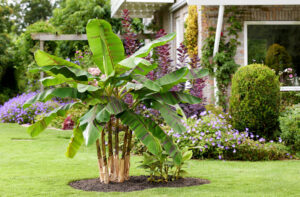
Banana ‘Ever Red.’
Credit: Concept Plants
Growers, local garden centers, and other plant experts mentioned the following 15 choices for my annual wintertime four-part, best-new-plants series.
Today’s post marks the final installment of this year’s best-new-plants series.
Part one on best new edibles of 2025 appeared on Jan. 14, part two on best new annual flowers of 2025 appeared on Jan. 21, and part three on best new perennial flowers of 2025 posted last Tuesday, Jan. 28.
Some of the following new tree and shrub varieties are available online and in some plant catalogs. Most also will be available in local garden centers beginning in April.
The details:
A banana tree for Pennsylvania yards? Don’t expect clusters of yellow fruits, but we can now grow a reliably cold-hardy ornamental version of banana with the 2025 arrival of the ‘Ever Red’ variety.
Maria Zampini, president of the Ohio-based Upshoot plant-introduction company, likes this new small tree from Concept Plants for its big, bold, and colorful tropical leaves.
“It has maroon red stripes in the foliage and is fast-growing,” she says. “As the name implies, it’s pretty hardy.”
Zampini says ‘Ever Red’ offers a showy tropical-looking addition to northern outdoor living spaces, where the plant can be grown in a large pot or planted in the ground.
Although ‘Ever Red’ is rated to USDA Hardiness Zone 5 (well within the range of winters throughout most of Pennsylvania), it’ll die back to the ground in our dormant season. Concept Plants recommends covering the roots with straw or mulch in winter.
Come spring, shoots rise eight feet or more (up to 12 feet) and grow those large green-and-maroon striped leaves.
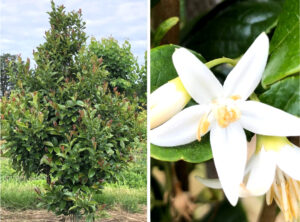
Snowbell Starway to Heaven, habit at left, flowers at right.
Credit: Proven Winners/ColorChoice
Another more conventional small tree turned enough heads at last September’s Farwest trade show to earn both the Best of Show Retailer’s Choice Award from The Garden Center Group and the People’s Choice voting by attendees.
Snowbell Starway to Heaven is a break-through on three fronts… 1.) it has a narrow habit of 12 to 18 feet tall but only eight feet in width; 2.) it’s a rebloomer, flowering in the traditional spring but also again in fall, and 3.) it has an unusual flower arrangement that one of its discoverers, Chris Robinson of Oregon’s Robinson Nursery, describes as “like a spiral staircase going up.”
Snowbell is an under-known, under-used small tree that hasn’t been widely planted in Pennsylvania because of marginal winter-hardiness. However, this one is rated for USDA Hardiness Zones 5-9, placing it well within most of the state’s climate norms.
Starway to Heaven’s flowers are fragrant, five-petaled, and as its wholesale grower, Michigan-based Spring Meadow Nursery, describes them, “shimmering and almost metallic in effect.”
The tree grows in full sun to light shade.
Another small tree that won a Garden Center Group Retailer’s Choice Award for 2025 is this new version of our native redbud tree – one small enough to grow in a pot (just eight to 10 feet in height) and with eye-grabbing dark burgundy leaves.
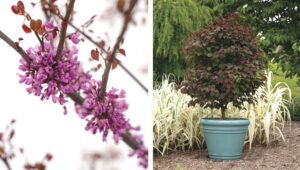
Redbud Garden Gems Amethyst.
Credit: Star Roses and Plants
Leah Palmer of Chester County grower Star Roses and Plants, which is introducing Garden Gems Amethyst, says the variety is a compact upright that was bred for small spaces and even containers.
She says the tree’s “rich burgundy foliage has good color retention through the heat of the summer,” and its pink blooms are abundant in spring.
Palmer adds that that combination makes Garden Gems Amethyst a good native specimen alternative to Japanese maples.
American dogwood Ragin’ Red
A third new small-tree introduction is a variety of our native American dogwood tree that not only produces red flowers instead of the usual white or pink but matches that with red new foliage.
“This tree has a quality I’ve never seen in a dogwood tree,” says Hershey Gardens horticulture manager Alyssa Hagarman, who rates Ragin’ Red as her favorite new tree of the year. “The new leaves emerge bright red in the spring and transition slowly to green in summer. It also has amazing bract color. The buds open in early May to reveal big, deep red bracts that surround small flowers. Red fall berries and (burgundy) fall foliage add to the show.”
The berries make a fall-favorite food to native songbirds, Hagarman adds.
Ragin’ Red grows about 20 feet tall and 15 to 20 feet wide, ideally in a site that gets morning sun and afternoon sun. Dogwoods also prefer rich, loose, slightly acidic, “woodsy” soil and despite compacted clay soil.
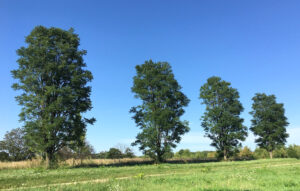
Kentucky coffeetree Skinny Latte.
Credit: Andrew Bunting/Pa. Horticultural Society
Kentucky coffeetree Skinny Latte
If it’s a bigger shade tree you’re looking for, Pennsylvania Horticultural Society Vice President of Horticulture Andrew Bunting recommends this narrow version of the midwestern-native Kentucky coffeetree.
Bunting likes Skinny Latte for its upright habit that can reach 50 feet tall but only about 18 feet wide.
“It’s a male selection, therefore there are not messy fruits,” Bunting adds. “Like other Kentucky coffeetrees, it is extremely urban tolerant and can grow in both wet and dry soils. It’s perfect as a street tree.”
Fall foliage is gold.
Skinny Latte is being introduced by Chicago’s Morton Arboretum through the Chicagoland Grows program.
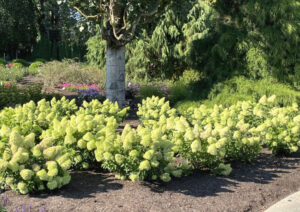
Hydrangea Dragon Baby.
Credit: Bloomin’ Easy Plants
Hydrangeas Dragon Baby and Grin and Tonic
In the shrub department, Bunting is keen on a pair of compact new hydrangeas being introduced in the Bloomin’ Easy line.
Dragon Baby is a summer-blooming panicle type that grows only two to three feet tall and wide.
Bunting says it produces “an abundance of white cone-like flowers that fade to pink at the end of the summer… It’s perfect for the city garden where there is limited space.”
He also likes the reblooming mophead hydrangea newcomer Grin and Tonic for its compact size and domed flowers that start out lime green and then turn pure white.
This one also tops out at only about three feet tall and wide, making it another small-garden option.
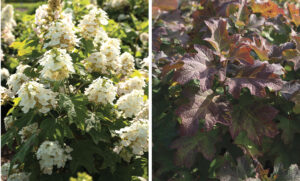
Oakleaf hydrangea Autumn Reprise, in bloom at left and fall color at right.
Credit: Star Roses and Plants
Oakleaf hydrangea Autumn Reprise
Hagarman’s top shrub choice for 2025 is this new oakleaf hydrangea from Chester County’s Star Roses and Plants.
She says Autumn Reprise has all the attributes that make native oakleaf types her favorite hydrangea – fall color, exfoliating bark, and large white blooms – but this one adds the trait of being a rebloomer.
The plant puts out a first set of cone-shaped white flowers in early summer and then a second round in later summer.
“It also is a bit earlier to bloom in the summer and has been bred to have improved disease resistance and better branching,” Hagarman adds.
Autumn Reprise grows about five to six feet tall and wide and does well in full sun or part shade.
Cascading hydrangea Fairytrail series
Hydrangea Fairytrail Bride broke new ground two years ago as the first of a new kind of hybrid hydrangea with a trailing habit.
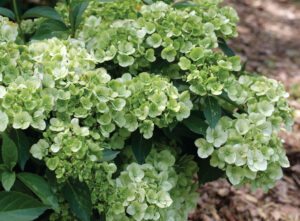
Hydrangea Fairytrail Green.
Credit: Proven Winners
The Proven Winners introduction has become a favorite shrub of Bryan Benner, the perennial and shrub grower for wholesale Quality Greenhouses near Dillsburg, who likes both the horizontal form and masses of white lacecap flowers that form all along the plant’s stems.
New for 2025 is a second and third entry: Fairytrail White, which is another white bloomer but with more mophead-type flowers, and Fairytrail Green, a trailer with lime-green flowers.
Both grow about four feet tall and wide, produce flowers all along the stems, and can be grown in containers and hanging baskets as well as draping over a rock wall. Morning sun and afternoon shade is ideal.
Smooth hydrangea First Editions FlowerFull
One more new hydrangea takes aim at overcoming the two main drawbacks of our native smooth hydrangea – floppy flowers and late-season leaf disease.
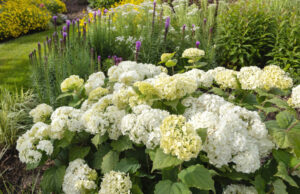
Smooth hydrangea FlowerFull.
Credit: Bailey Nurseries.
Author and Bailey Nurseries communications manager Ryan McEnaney says First Editions FlowerFull gives home gardeners “that classic white flower on sturdy stems that don’t flop in the rain, better resistance to leaf spot, gorgeous lush leaves, and two to three times the flowers of ‘Annabelle’ (the flagship variety) per season. It may look similar in the pot at the garden center, but it’s a totally different plant in the landscape.”
FlowerFull grows three to four feet tall and four to five feet wide, either in full sun or part shade.
This new broadleaf evergreen shrub variety with the odd name also is unusual for its foliage, which is a changing variegated combination of pink, green, cream, and bronze, depending on the season.

Leucthoe ‘Paisley Pup.’
Credit: Proven Winners.
Known by the common name of “doghobble,” leucothoe ‘Paisley Pup’ is a Proven Winners newcomer that earned a 2025 Retailer’s Choice Award of Merit from The Garden Center Group for its showy looks.
Doghobble is also a native shrub that attracts pollinators with its bell-shaped white flowers that run all along the plant’s arching branches in late spring.
Besides staying evergreen in most winters, ‘Paisley Pup’ is deer-resistant and disease-resistant.
It grows about four feet tall and five feet wide, ideally in part shade (or at least out of direct afternoon sun).
Butterfly bush Summerbird Raspberry and Summerbird Blue Improved
Butterfly bushes have fallen out of favor lately for their invasive-seeding tendencies, but Dr. Alyssa Collins, director of Penn State University’s Southeast Agricultural Research and Extension Center in Lancaster County, says these two are high-performers that have shown no signs of seeding at all in Penn State Trial Gardens’ trials.
Summerbird Raspberry is a raspberry-pink bloomer, while Summerbird Blue Improved blooms in a lilac-purple shade. Both are compact selections from Benary Plus that grow only about two to three feet tall and wide. Both also scored a perfect five in Penn State’s 2024 trials.
“They have given us long bloom times and a nice volume of plant without being rangy,” Collins says. “They have stayed neat, tidy, and controlled in habit and have never produced any seedlings. The Master Gardeners who help tend these plants have been very careful to note this considering the invasive nature of previous varieties.”
Butterfly bushes flower best in full sun and usually aren’t bothered by deer.
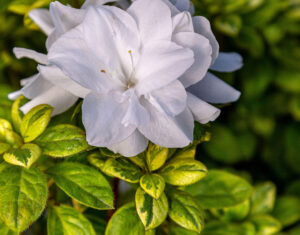
Encore azalea Autumn Moonstruck.
Credit: Encore Azaleas.
Azalea Encore Autumn Moonstruck
This newest introduction in the ever-growing series of reblooming Encore azaleas is the favorite new 2025 woody plant of Katie Dubow, president of the Chester County-based Garden Media Group and author of its annual Garden Trends Report.
Dubow says Encore Autumn Moonstruck stands out mainly for its chartreuse and emerald variegated foliage – the first variegated introduction in the 35-variety Encore line. But she also likes the plant’s exceptionally long bloom time… it can put out large, semi-double white flowers during parts of spring, summer, and fall.
Autumn Moonstruck is an evergreen azalea that’s rated to survive in USDA Hardiness Zone 7a, which makes it doable in most of the Harrisburg area but not in colder Zone 6 and 5 parts of Pennsylvania.
Figure on a size of five feet tall and four feet wide, ideally in a site that gets morning sun and afternoon shade.
In the new-rose department, Star Roses and Plants’ Palmer says the best newcomer coming out of the company’s breeding this year is Brick House Orange. (Star is best known for its award-winning rose introductions.)
Palmer says Brick House Orange is a floribunda type with the same rounded, compact form as Brick House Red and Brick House Pink, except its flowers are a vibrant orange-red in color.
“This is the most disease-resistant rose series after Knock Out, and it has top landscape performance across the country,” she adds.
Brick House Orange grows about 1½ feet tall and 2½ feet wide, ideally in full sun. It blooms from late spring almost continuously into fall, says Palmer.
Read George’s post on best new trees and shrubs of 2024







